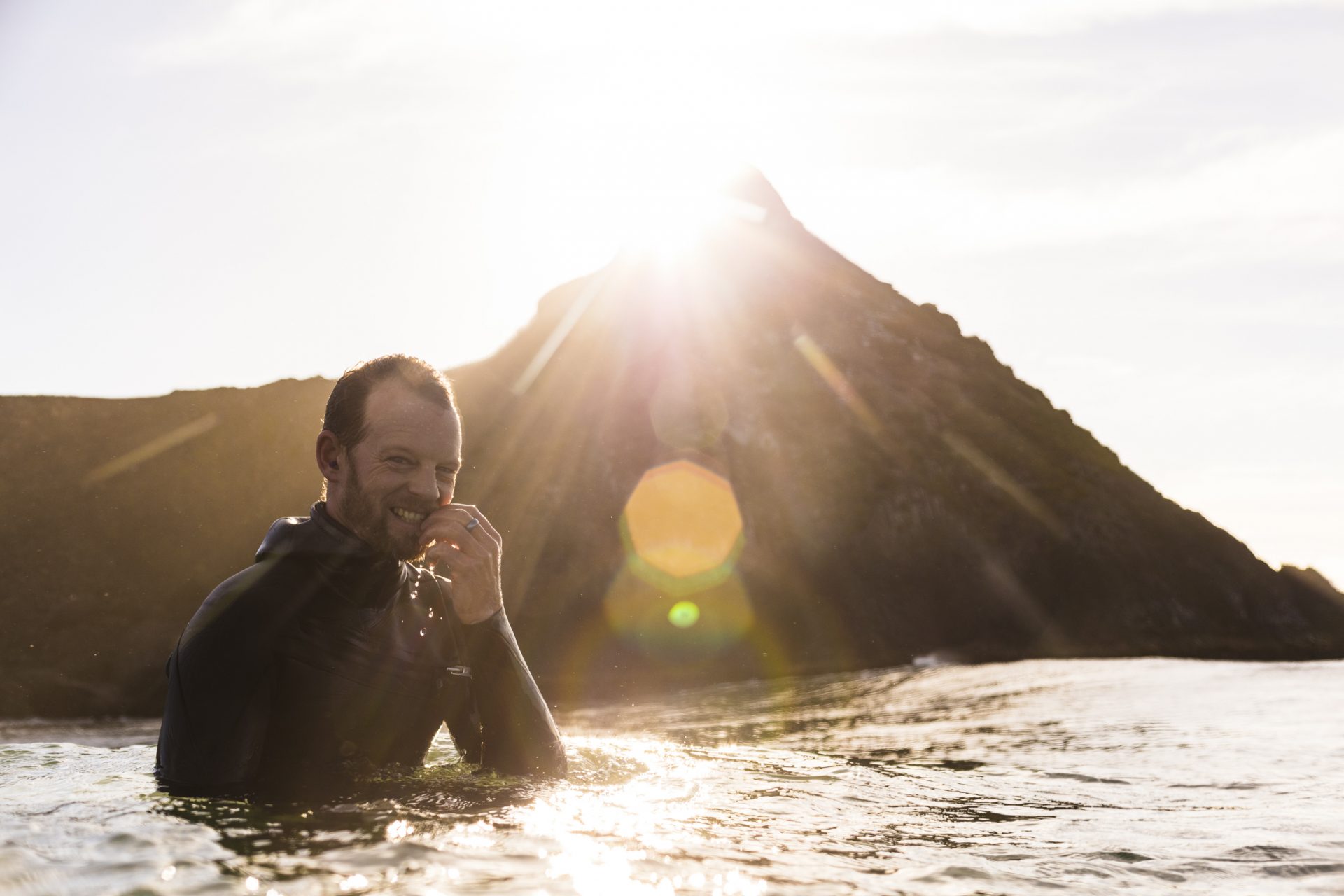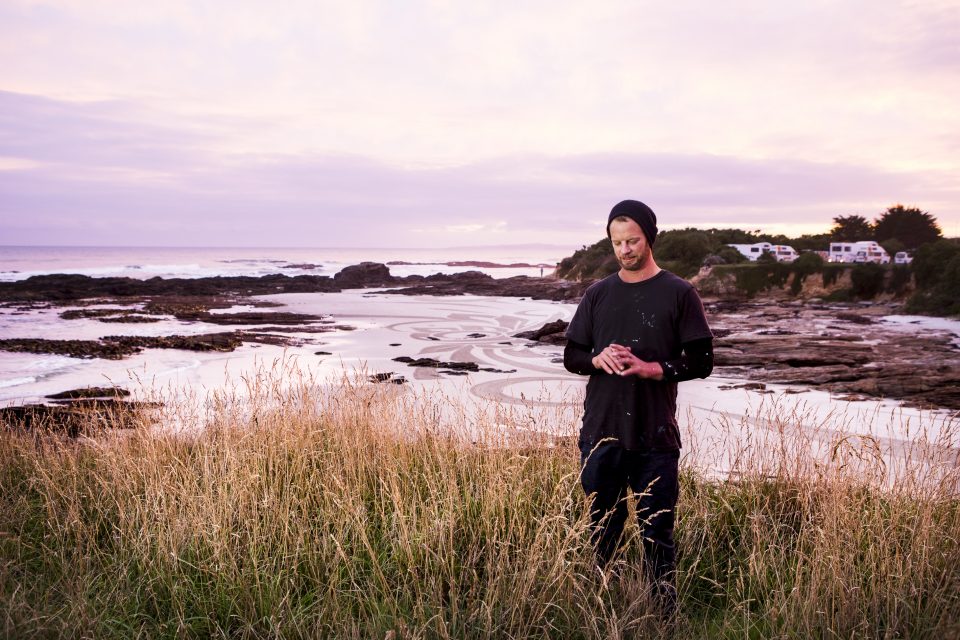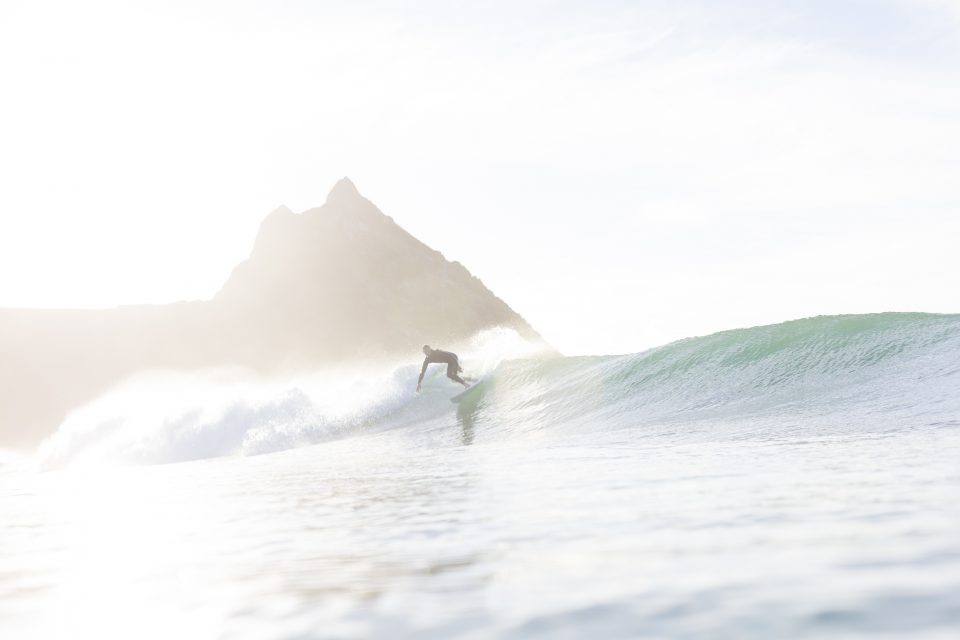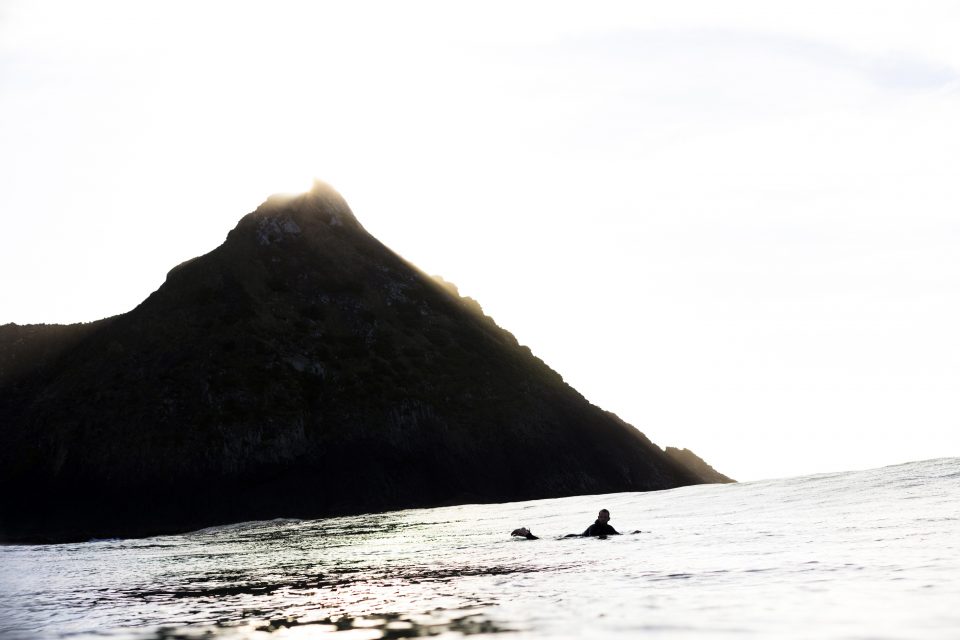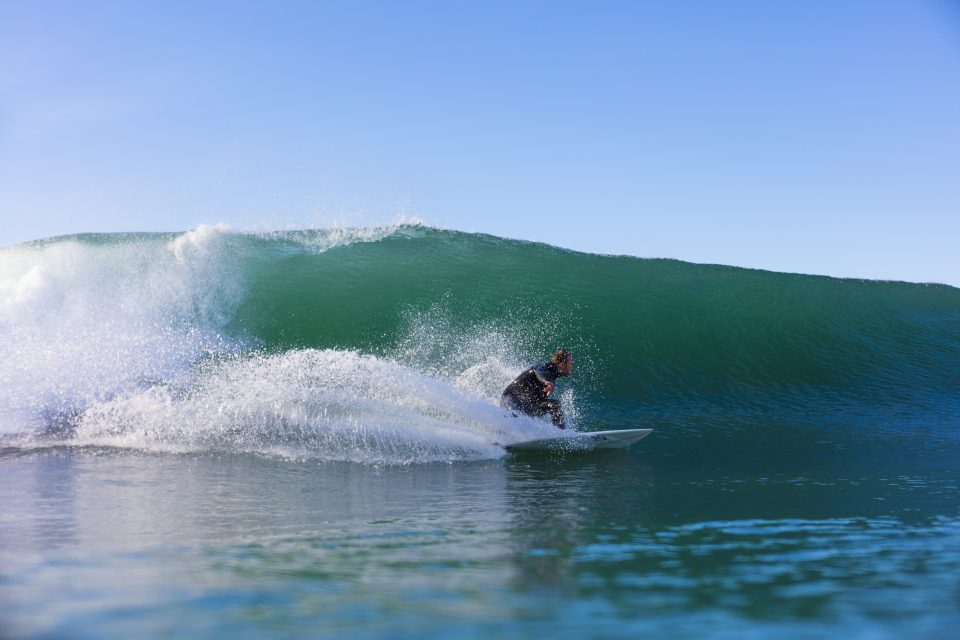Ian Ross makes art that has a lifespan as long as a tide. And that doesn’t faze the talented surfer and nearly 40-year-old Californian artist. Sand art, as he describes it, is a series of shapes etched with a rake into the intertidal sand zone. Ian is a master of it.
He first saw locals raking the sand at his home break: Ocean Beach in San Francisco. Ian bought a rake and fell in love.
“It was just like my paint brush worked and to my surprise it all just felt so natural,” he explains. “Just like a calligraphy-style brush – a flat, wide brush, which was exactly what I loved to use.”
We met Ian and his wife and business partner Daniele at the Heritage Café on Vogel Street in Dunedin where he was putting the finishing touches on a mural of vines that curl across the outdoor dining space. He’s in New Zealand to celebrate his good friend, Damien Van Brandenburg’s marriage to Ash, “and for the exceptional sand art conditions”, he laughs as he rubs his paint-splattered hands together.
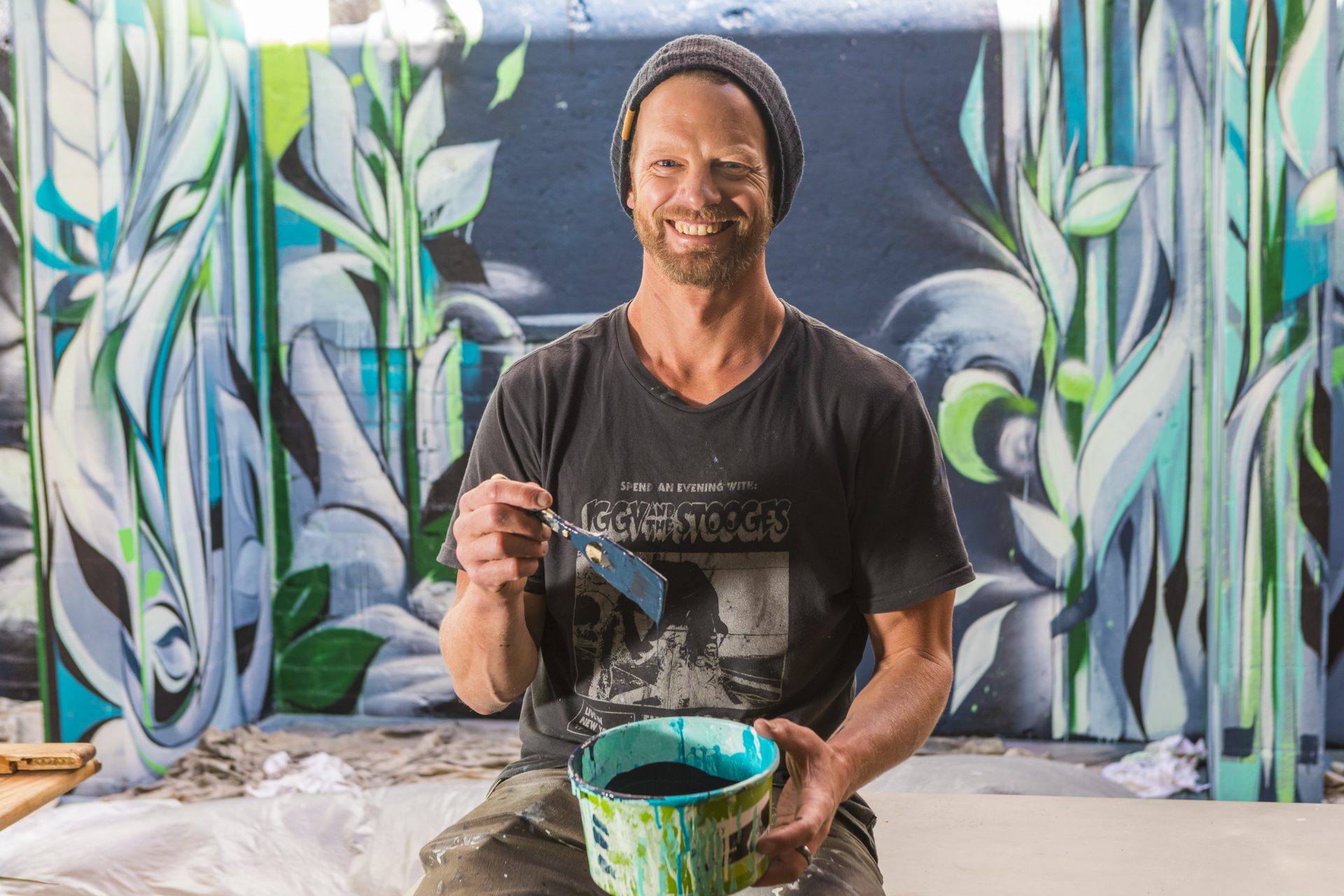
“The first time I went out to rake the sand I just ran around and around in circles for an hour and a half and it came out amazing,” he shares. “That was three and half years ago. I love doing it more than any other type of art right now. It’s just such an ephemeral experience and everyone who witnesses it realises that it’s temporary and they connect with that energy. I like that it is not leaving any waste – it’s not requiring any materials, it’s complementing a beautiful natural environment.”
“I’m attracted to this quick, beautiful process – no one can own the work, it’s gone in a couple of hours and it’s just all about the pure creative moment.”
Ian said he hoped his beach art would draw attention to all the issues affecting our coastlines and oceans.
“We’re facing a lot of harsh realities right now and my sand art is a way to bring attention to these natural areas and to support those who are doing something to change the bad behaviours,” he explains. “If that’s the one thing I can do then it seems to be a pretty powerful tool.”
I’m attracted to this quick, beautiful process – no one can own the work, it’s gone in a couple of hours and it’s just all about the pure creative moment.
Ian said he was always looking for ways to take that further. He planned to start making books and prints with the sand art and donating proceeds back to those working to protect the areas where he did the art.
Ian pauses and surveys the mural inside the café. He soon finds a natural rhythm with the paint brush in a leafy corner. He appears to go into a trance as the creative pulse takes over.
“When I’m working I just try to get my mind out of the way and just react to the work and to the spatial arrangements of the shapes,” he reveals as he mixes up another palette. “I’m always trying to find a balance. Like when you’re out hiking and you come around a corner and there’s a waterfall going into a bunch of boulders and there’s a tree growing out of one of the boulders somehow. It has found this way to fit into this odd spot, but it all makes sense. That’s what it feels like when you’re out in nature. I try to get my work to a place where those forms are fitting in with all the other forms. There is no right answer – it is all intuitive. There’s something about witnessing something beautiful in nature – you understand that it is beautiful and balanced and grown to be there. If I can get my work to do that and to give that calming effect then that is a successful work.
He said it was the same on the beach, but simplified.
“On the beach the shapes are much larger, flat shapes and I work to make each shape pure, smooth and beautiful. And I just add the next shape and let them grow out naturally – I never know what they’re going to look like in the end. That can make it tough to fit into a schedule,” he laughs shaking his head. “Sometimes they need more time. It feels like magic when you get there – that one last touch, connecting line or spray of colour can complete it. It all comes together and feels right.”
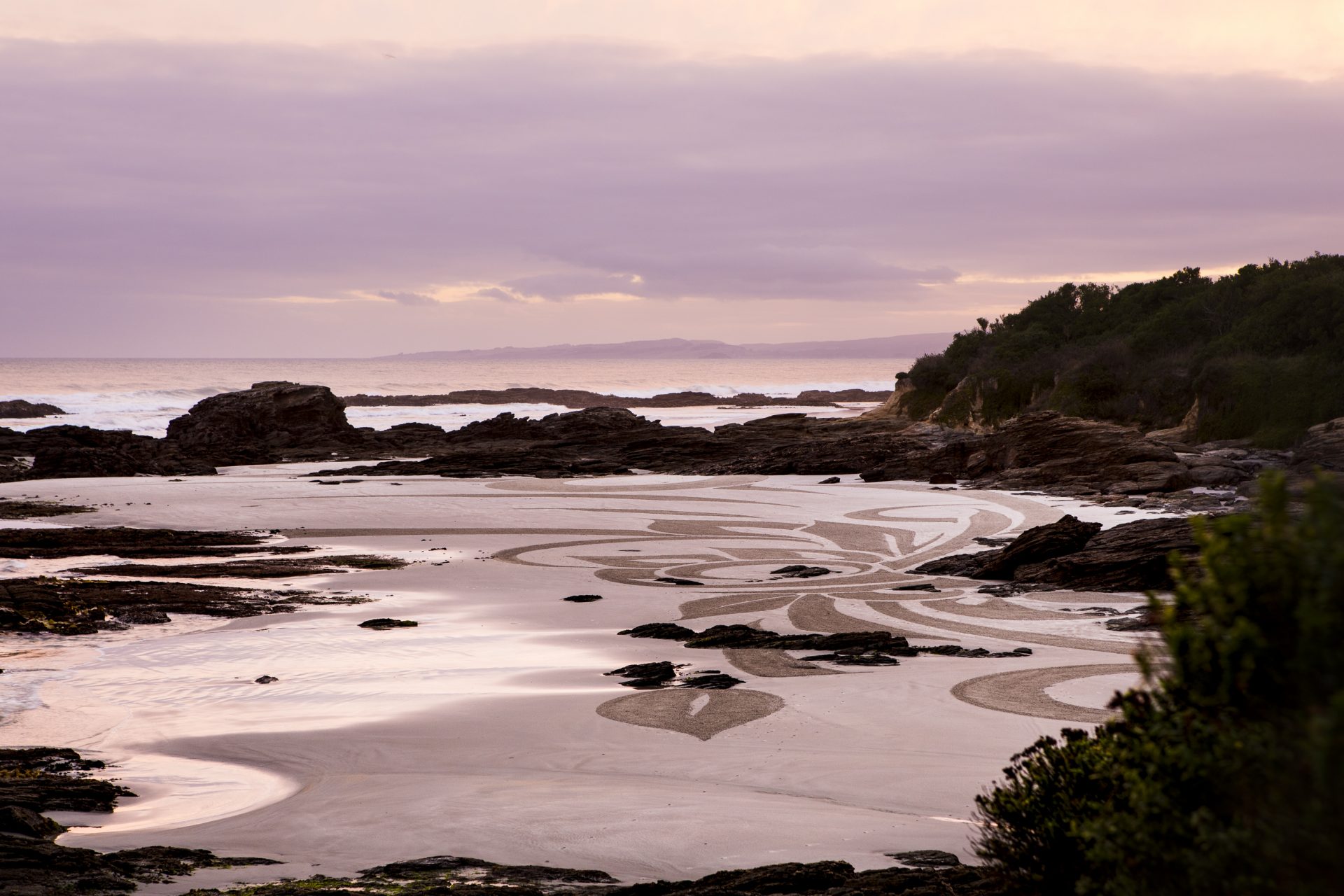
He said the beach art had taken him a long time to understand and he had to learn that less was more.
“The Brighton piece really surprised me as to how well it fit the rocks and shape of the coast,” he explains. “I wasn’t sure about some of the circles, and the shape of the exposed sand looked like a sea horse with big striations in the rock coming out of the ocean and the rock coming through the sand. I try to work with the character of the beach and the lines that are already there.”
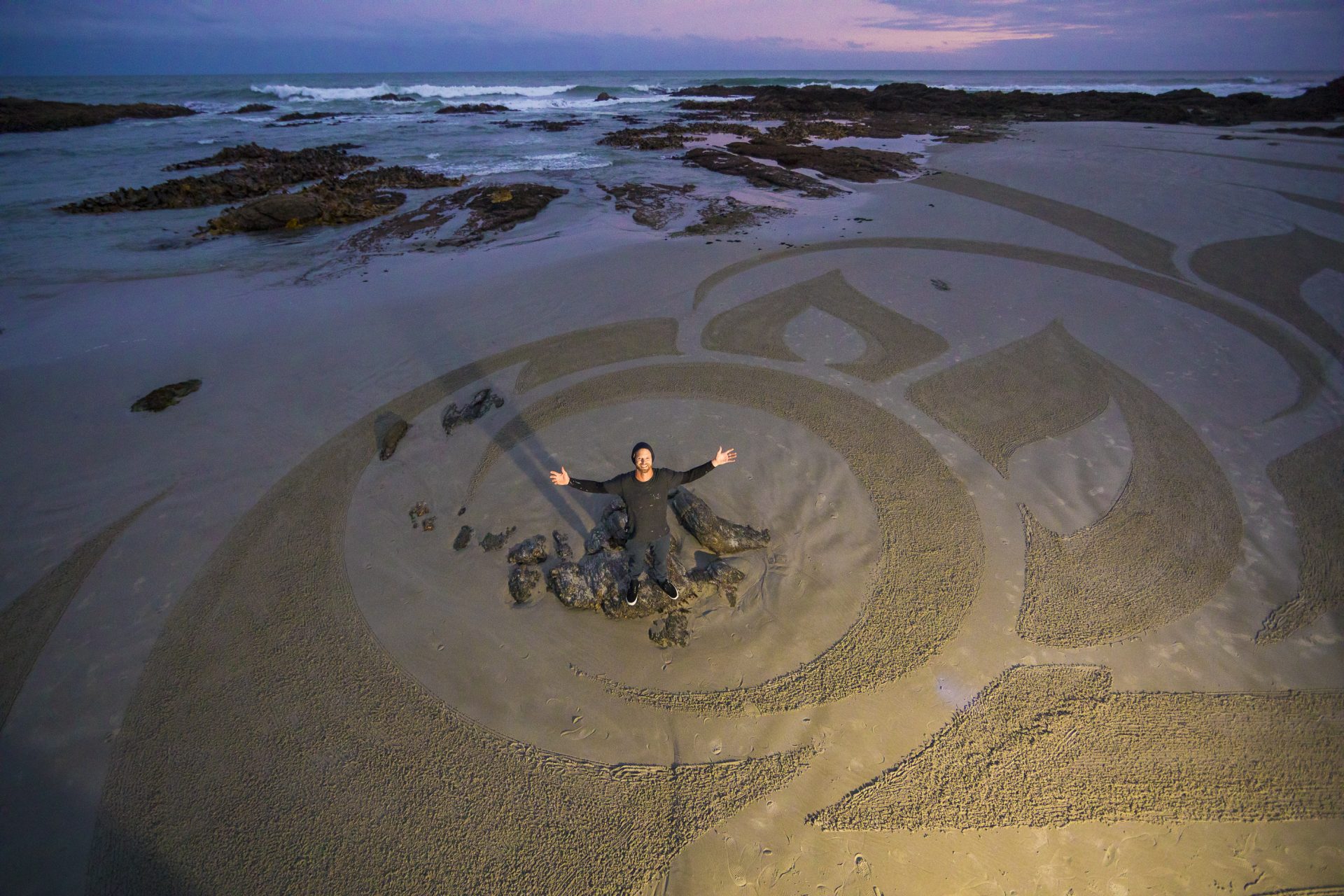
The Heritage Café piece he estimates is probably about a five-day piece, but by the time he’s factored some sand art and some surfing into his days it will require more than a week.
“I approach my work like an installation and try to make it fit the space so it feels like it is part of the place,” he tells me. “That sometimes takes a little longer and I end up doing extra, but I’m happy as long as the viewer is engaged when they’re out here having their coffee with all the plants – they should feel immersed in it. The arches mirror the architecture here and the heritage area – it connects the energy of the space.”
For the past 25 years, Ian has been chasing the best and most interesting waves he can find. New Zealand has always been on his radar, but this is his first visit here.
“I heard once or twice that there were waves over here,” he laughs. “Whenever I am surfing a new spot it is an epic feeling – whether it is going off or not – it’s just nice to experience a new surf zone and learn the geography, winds and to get an idea of what is possible for the waves. That’s always rad. And I got some super fun waves – this one Blackhead session was the highlight and the first morning I got here I surfed St Clair overhead, fun and with no one else around. But I definitely want to see the real deal – I was looking through the book Seasons and it looks like there are some sick waves around here.”
Ian’s left eye is blackened with cut marks in a couple of places like he has been brawling between brush strokes. It’s self-inflicted he insists.
Whenever I am surfing a new spot it is an epic feeling – whether it is going off or not – it’s just nice to experience a new surf zone and learn the geography, winds and to get an idea of what is possible for the waves. That’s always rad.
“There were two packs – one near the left we surfed and one further down the beach and the second peak had this bowly right on it, but everyone was focused on the left. The right came in and wrapped back against the grain across the bar and you’d get so much speed on it. I was just lapping it for about two hours until I hit my eye,” he recalls with a shake of his head. “I got out of the water and ran up to this older gentleman on the beach who was about to paddle out and asked him to check out my eye. I wasn’t sure how bad it was but I knew it was bleeding and cut in two places. He said, ‘that one’s a scratch and that one’s blistered, you don’t need stitches. You’re going to have one hell of a black eye, but you’re fine’. So, I went back out and had a little bloodied-face session for the rest of the morning.”
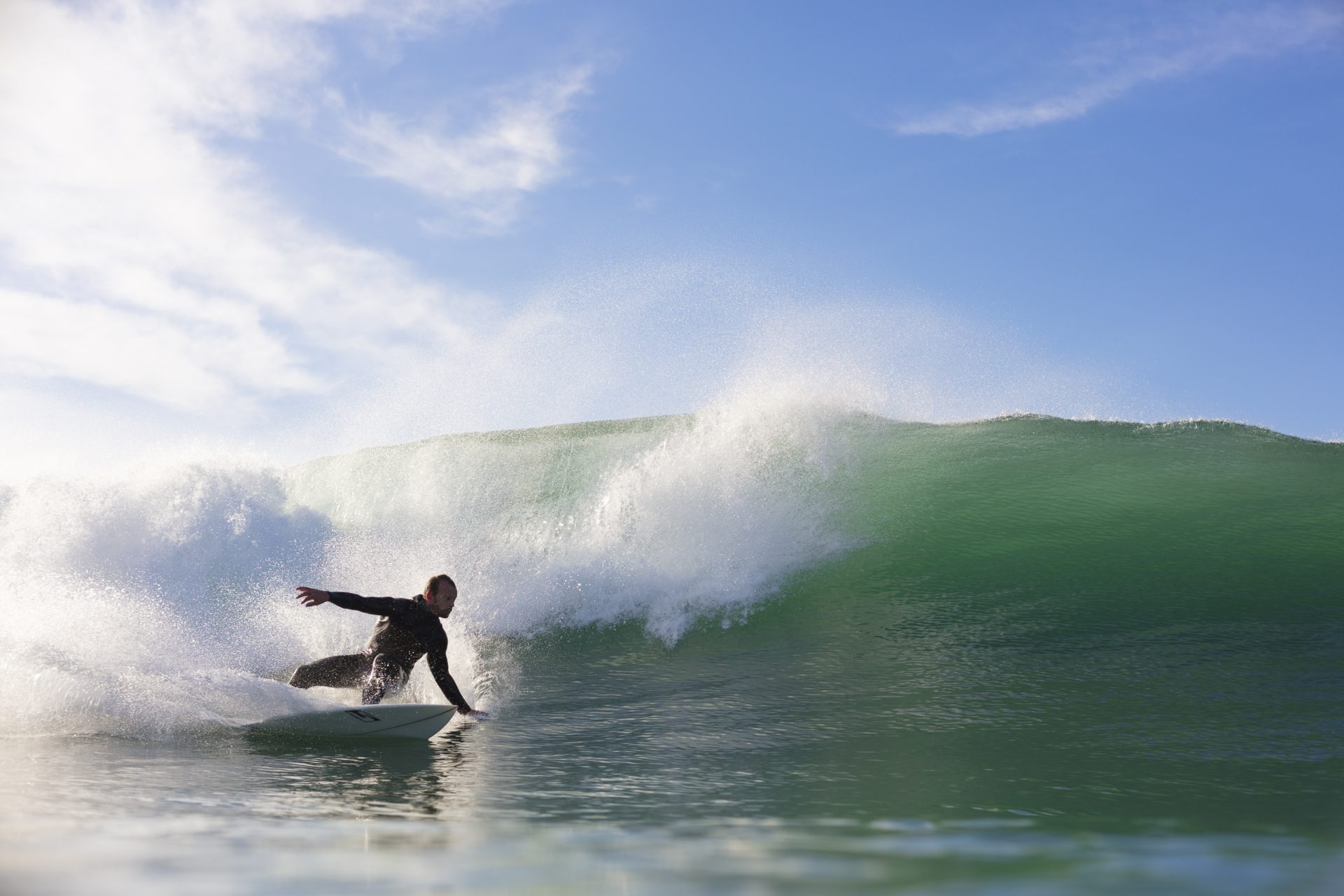
A third generation artist, Ian said that never put any extra pressure on him.
“My Dad was always trying to talk me out of it: ‘You don’t want to be an artist for your whole life – you’re going to suffer and it will be horrible’,” he laughs as he recalls the advice. “But at the same time I have seen my Mum and Dad with all this freedom and being able to do whatever they wanted to do. They could work from home and be with their kids when they were young. I thought, that seems like the ultimate in a way – you can do what you love and on your own terms. That has taken a lot of time, sacrifices and tough decisions to get to that point – it certainly isn’t easy in the beginning. But hard work and treating people right can get you anywhere I think. If you believe in what you’re doing you’ve just got to plug away.”
Ian has made art his whole life, but didn’t start painting until after university where he did a BFA in Ceramics.
“We had the most advanced under graduate ceramics programme in the world. No one really majors in ceramics – you’re basically just signing up to be a ceramics professor,” he laughs. “But I just really wanted to see if I could be an artist and make a living selling my art. I moved back to San Francisco and sold all my wheels and kilns and all the equipment that I had and went to Indonesia for the summer. I came back and broke up with my girlfriend of seven years and just started painting out of frustration. I haven’t touched clay now in 13 years. Sometimes life just takes a turn and you have to roll with it.”
He said that was how he liked to work.
“That is what my work is about – the process of making these decisions and the compounding effects of those decisions and trying to be close to nature. I think the gesture of the human body is a way for us to be closest to nature,” he admits making broad brush strokes in the air. “It’s to do the most natural thing that our body wants to do. I think that is where a lot of graffiti, calligraphy, line work and brush work is linking us to how forms grow in nature.”
“That’s why my stuff looks like plants I guess,” he admits with a chuckle.
Nature was never far away in his early years.
“I grew up climbing trees and digging in the dirt in Marin County just north of San Francisco,” he offers. “My parents were artists and did ad design for a cement mixing building company in the area. They were really cool people and their boss let them live in the house next door to him, so we had two and a half acres on the top of the hill in some of the most valuable real estate in the country. So somehow I got to grow up on what was basically an estate. We didn’t watch TV, we were outside and I think that’s what inspired me.”
But it was the city that implanted a deep-rooted fascination for street art.
“When we got older we’d go straight into San Francisco, take our skateboards and take the ferry over and we started to see graffiti everywhere and learn about that. When I went to college I saw graffiti on the trains and graffiti everywhere,” he remembers. “I never became a graffiti writer, but I was extremely interested or obsessed with the evidence of speed and the risk these guys and girls were taking to get their work out in front of their peers. The mass volume that was able to be produced in a small amount of time was just mind-blowing to me. That fueled a huge amount of my creativity over the years – this interesting juxtaposition between nature and its dense beauty of forms and humans and this art form of graffiti that spawns right out of that human density in a city. Those two things exist right next to each other where I am from. Golden Gate Bridge on one side is open space and nature, and on the other side is this incredible international city with so many different nooks and crannies and moods and faces. It’s a really awesome city.”
He said San Francisco had changed a lot with the tech influence and that had been a big part of his career as well.
“I spent two years at Facebook as their in-house artist,” he shares. “Before they went public I did a live mural at their headquarters and during that time they offered me a warehouse to work in. So I became the second artist there and did about a dozen murals for them. Then when they went public they got rid of all their little warehouses and everything became really corporate and they blew up to this mega, crazy whatever they are now. They only had like 1500 employees when I was there and I tried to get stock like the first artist David Choe – he made a whole bunch of money in 2005 by choosing to be paid in stock, rather than take the $60,000 offered. He was gambling on Sean Parker one of the founders. He took the stock and when Facebook went public that stock was worth around $200 million. And I was the next artist. Since then they have helped 100s with their artist in residence programme.”
I think the gesture of the human body is a way for us to be closest to nature. It’s to do the most natural thing that our body wants to do. I think that is where a lot of graffiti, calligraphy, line work and brush work is linking us to how forms grow in nature. That’s why my stuff looks like plants I guess.
He said a lot of the start-ups and tech companies wanted to embody the energy that big companies like Facebook and Google brought to their work environments.
“Murals make a space cool and everyone wants to work at a cool place, so I have found a niche for my work in that world and that’s why my wife and I opened an art gallery in San Francisco once I left Facebook,” he explains. “We were right in the hub of it all – 500 start-ups within half a mile and Wired Magazine headquarters and all these crazy people trying to change the world.”
“That’s where I met Damien.”
A Dunedin architect with Architecture Van Brandenburg, which holds a philosophy that design should be led by nature, Damien held his Unfurling exhibition in Ian’s gallery space in San Francisco in 2015. The two soon discovered they were on the same wavelength.
“A mutual friend put us in touch, but when I saw what they did I thought, if I was to create buildings then this is pretty much exactly how I’d like to do it,” he smiles. “It blew my mind how similar the styles were and the fit of the aesthetic. I’m still trying to get my head around it. It’s inspirational to say the least. Who knows what the future may bring.”
If Ian has his way then the future will bring more consideration for the environment.
“I want to continue to work with materials that are biodegradable or even without materials – like for beach art,” he announces as he stands back to admire the mural. “I like to work outside and to benefit environments that I care about. I’d also like to figure out some sculptural stuff and install it illegally – kind of like guerrilla art, but using materials that are completely biodegradable so if the work does fall down, or gets knocked over then it is not going to be litter. That leads me down a road towards landscape architecture and living installation, but I want it to still be art and art that could outlive me and that maybe people need to maintain if they’re the owners of it. To create environments that benefit humans naturally.”
To follow more of Ian’s work jump on to Instagram and follow @ianrossart.

